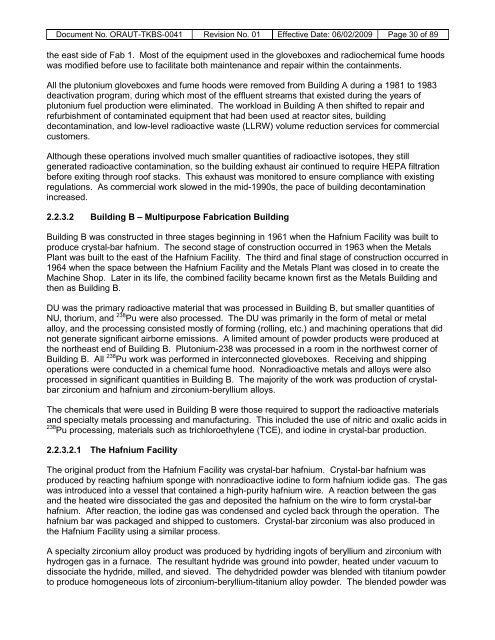ORAU TEAM Dose Reconstruction Project for NIOSH
ORAU TEAM Dose Reconstruction Project for NIOSH
ORAU TEAM Dose Reconstruction Project for NIOSH
Create successful ePaper yourself
Turn your PDF publications into a flip-book with our unique Google optimized e-Paper software.
Document No. <strong>ORAU</strong>T-TKBS-0041 Revision No. 01 Effective Date: 06/02/2009 Page 30 of 89<br />
the east side of Fab 1. Most of the equipment used in the gloveboxes and radiochemical fume hoods<br />
was modified be<strong>for</strong>e use to facilitate both maintenance and repair within the containments.<br />
All the plutonium gloveboxes and fume hoods were removed from Building A during a 1981 to 1983<br />
deactivation program, during which most of the effluent streams that existed during the years of<br />
plutonium fuel production were eliminated. The workload in Building A then shifted to repair and<br />
refurbishment of contaminated equipment that had been used at reactor sites, building<br />
decontamination, and low-level radioactive waste (LLRW) volume reduction services <strong>for</strong> commercial<br />
customers.<br />
Although these operations involved much smaller quantities of radioactive isotopes, they still<br />
generated radioactive contamination, so the building exhaust air continued to require HEPA filtration<br />
be<strong>for</strong>e exiting through roof stacks. This exhaust was monitored to ensure compliance with existing<br />
regulations. As commercial work slowed in the mid-1990s, the pace of building decontamination<br />
increased.<br />
2.2.3.2 Building B – Multipurpose Fabrication Building<br />
Building B was constructed in three stages beginning in 1961 when the Hafnium Facility was built to<br />
produce crystal-bar hafnium. The second stage of construction occurred in 1963 when the Metals<br />
Plant was built to the east of the Hafnium Facility. The third and final stage of construction occurred in<br />
1964 when the space between the Hafnium Facility and the Metals Plant was closed in to create the<br />
Machine Shop. Later in its life, the combined facility became known first as the Metals Building and<br />
then as Building B.<br />
DU was the primary radioactive material that was processed in Building B, but smaller quantities of<br />
NU, thorium, and 238 Pu were also processed. The DU was primarily in the <strong>for</strong>m of metal or metal<br />
alloy, and the processing consisted mostly of <strong>for</strong>ming (rolling, etc.) and machining operations that did<br />
not generate significant airborne emissions. A limited amount of powder products were produced at<br />
the northeast end of Building B. Plutonium-238 was processed in a room in the northwest corner of<br />
Building B. All 238 Pu work was per<strong>for</strong>med in interconnected gloveboxes. Receiving and shipping<br />
operations were conducted in a chemical fume hood. Nonradioactive metals and alloys were also<br />
processed in significant quantities in Building B. The majority of the work was production of crystalbar<br />
zirconium and hafnium and zirconium-beryllium alloys.<br />
The chemicals that were used in Building B were those required to support the radioactive materials<br />
and specialty metals processing and manufacturing. This included the use of nitric and oxalic acids in<br />
238 Pu processing, materials such as trichloroethylene (TCE), and iodine in crystal-bar production.<br />
2.2.3.2.1 The Hafnium Facility<br />
The original product from the Hafnium Facility was crystal-bar hafnium. Crystal-bar hafnium was<br />
produced by reacting hafnium sponge with nonradioactive iodine to <strong>for</strong>m hafnium iodide gas. The gas<br />
was introduced into a vessel that contained a high-purity hafnium wire. A reaction between the gas<br />
and the heated wire dissociated the gas and deposited the hafnium on the wire to <strong>for</strong>m crystal-bar<br />
hafnium. After reaction, the iodine gas was condensed and cycled back through the operation. The<br />
hafnium bar was packaged and shipped to customers. Crystal-bar zirconium was also produced in<br />
the Hafnium Facility using a similar process.<br />
A specialty zirconium alloy product was produced by hydriding ingots of beryllium and zirconium with<br />
hydrogen gas in a furnace. The resultant hydride was ground into powder, heated under vacuum to<br />
dissociate the hydride, milled, and sieved. The dehydrided powder was blended with titanium powder<br />
to produce homogeneous lots of zirconium-beryllium-titanium alloy powder. The blended powder was

















